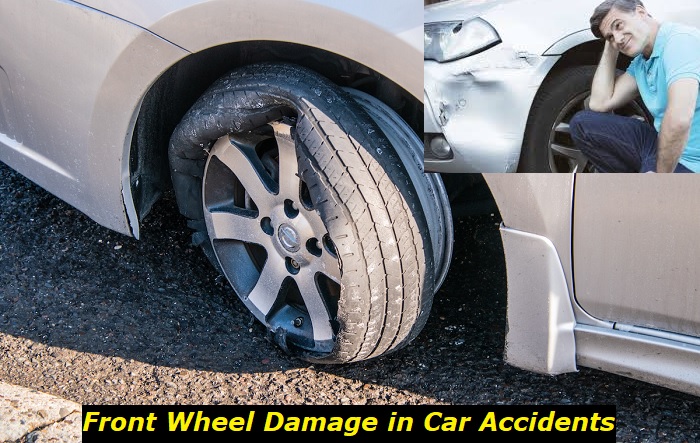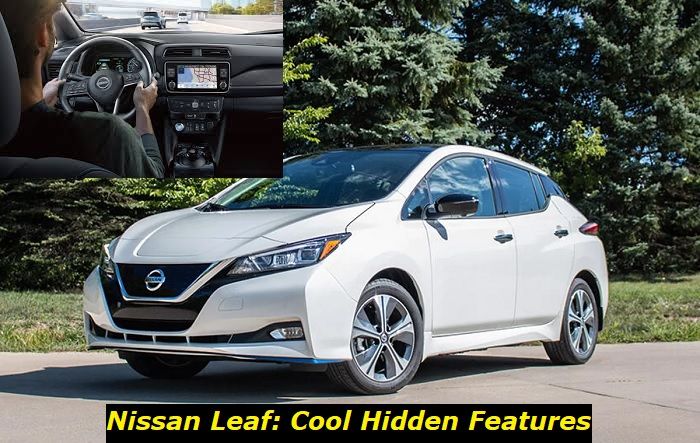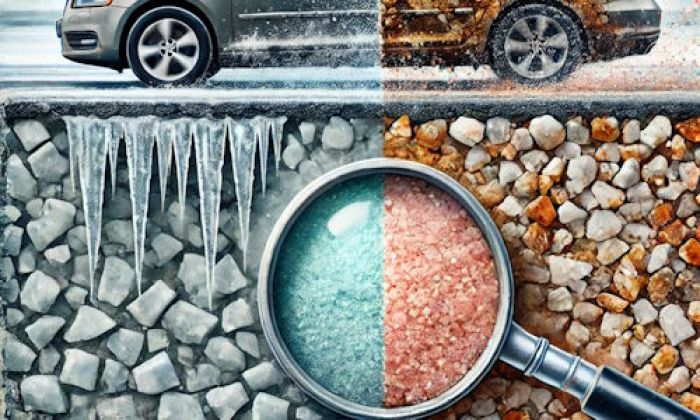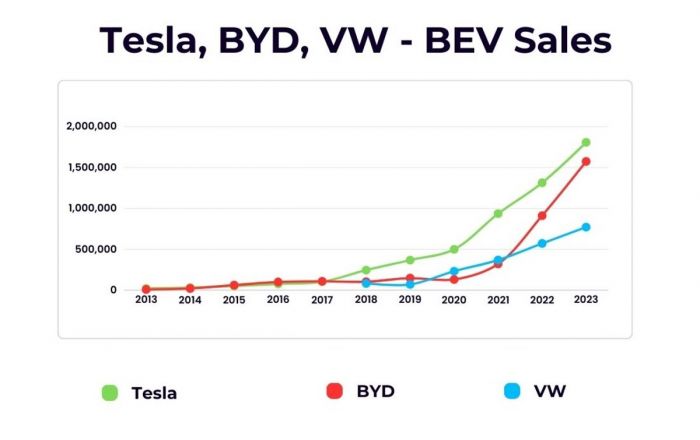If a road accident hit the front wheel of your car, there may be problems with the suspension part, steering system, transmission, and also wheel alignment as well as with the body. After such an accident, you should immediately go to the specialists and have the car inspected properly. Also, you should drive it carefully and watch how it reacts to different road conditions.
Front suspension problems highlights
- Level of importance:high
- Common reasons:road potholes, speed bumps, age, mileage
- DIY inspection:possible but complicated
- DIY repair:usually,impossible
- Average price in shops:$250 - $800
- Average time:2 - 8 hours
- If ignored:fatal failure, no drive, expensive repairs

Accident types that affect the front wheels of your car
It's not that uncommon that after car accidents cars have damaged front wheels. You may or may not see some types of problems with the wheels but when the accident actually hit that area, you should be careful. Your front wheels are responsible for everything - acceleration, braking, steering, traction, etc.
Even a relatively small hit on the wheel may lead to bad consequences. Although the wheel assembly is pretty tough when it comes to road bumps and pits, it's not that mighty when you hit it from the side.
Here are the types of accidents that involve front wheels:
- Hitting the curb. This is not even a pure accident because it often takes only your car and a curb without anyone else participating in the performance. But the consequences may still be pretty bad.
- Side impact. When some other car hits your vehicle on the side, it may eventually harm the wheel and suspension. Very often, damages are really bad when the impact is right in the area of the wheel.
- Side-to-side hit. This may happen when both cars intend to change lanes and don't see each other. When they touch, the contact often happens right in the area of the front wheels.
- Sharp braking and hitting some obstacle. When you are trying to avoid a car accident, you may steer your vehicle to some bad area with obstacles and eventually hit the wheel over something.
- Undercarriage. When something damages the undercarriage of your vehicle, it may also hit the wheel from the inside. Very often, this affects the suspension and other parts making the wheel disabled.
So, as you see, there are several types of accidents that may directly affect the front wheel of your car. It means that the wheel can be damaged and you will not be able to drive the car after the accident is sorted out.
Unfortunately, car accidents with front-wheel damages are so common that this is one of the most important questions people ask before they decide what to do with their cars. This is especially important if you don't have proper insurance coverage and need to pay for the repairs. Front-wheel accidents are pretty unpredictable in terms of repair costs.
What can be damaged when you hit the front wheel?
Unfortunately, hitting the front wheels doesn't come without damage. Sometimes, it's something cheap and not important but very often, the problems may be really huge. There are a lot of things in the wheel well that may immediately make your vehicle undrivable. Also, some of these parts are extremely important for safety.
I've compiled a list of things and units that can be damaged when you hit one of the front wheels. Each of these things is worth checking after an accident.
1. Tires
A tire is made of rubber and it can be easily damaged. When there is a side hit, the tire may be torn. Also, when the vehicle is in a serious accident, the tires will suffer because of the unnatural contact with the road.
Sometimes, your tire may just slip from its natural place and lose all the air. But often such accidents can also lead to issues with the condition of the tire itself. If there is a big crack in the tire, there is no way you can repair it - only replacement is possible.
2. Wheel rims
Secondly, you need to pay attention to the condition of the rims. Even if they look good, you should go and have them checked on special equipment. Even tiny damage may lead to problems when driving. Whatever type of wheel you have, it may lose its shape and eventually cause problems when you are trying to drive the vehicle.
Rims are pretty tender when it comes to side hits, so after any accident like a curb hit or car collision you should have them checked.
3. Suspension parts
If after an accident you see that your wheel is in the wrong position, the first culprit of this is the shock absorber. It may have been bent and now the entire suspension is positioned wrongly. There is no way you can repair a bent shock, you can only replace it.
Also, the hub may be damaged because of the hit. Very often, in such cases, you will have a broken or stuck wheel bearing. Of course, suspension arms, bushings, and fastenings should also be checked. They may experience the biggest impact and they may need replacement.
4. Steering system units
The wheel has a lot of steering systems near it, so some parts of this system may be damaged. Your steering rods and rod ends are connected to the wheel suspension and they are most likely damaged in this situation. If the hit was quite strong, you should also check the steering rack.
If something is wrong with the steering system, there is no chance for you to drive the car after the accident. Driving will only be possible after you repair the vehicle.
5. Transmission and axle shafts
One more part that is connected to your wheels is the transmission. The connection is realized with the help of the axle shaft. The shaft has inner and outer joints on both ends - they also may die after such a hit. The axle shaft may be bent.
But the worst thing is if the axle shaft hits the transmission. In this case, the transmission may get some cracks in its body or even inner damage by the joint. It's worth checking the transmission after such a mishap.
How can you check and locate the issues?
Very often, you will want to troubleshoot the vehicle before you send it to the repair shop. For this, you will obviously need some knowledge. But there are some DIY ways to check things out.
Here's what you can try:
- jack up the car on the side that was affected by the accident;
- take off the wheel and investigate the tire and the rim, especially on the inner side;
- inspect the wheel hub and see if it's misshaped or has some visual damage on it;
- look at the shock absorber which you now clearly see - it shouldn't be bent even a little;
- look at the suspension arms that you may see if you look under the vehicle, they shouldn't be affected;
- take the axle shaft in your hand and try shaking it - it shouldn't have serious free play;
- also, shake the steering rod to find out if there is some free play;
- put the wheel back on the car, start the engine, and check the steering wheel for significant bumps when you turn it;
- press with your hands on the side of the car that is affected and check if the strut and shock absorber are OK;
- look under the car and check if there are no liquids leaking from the transmission or other units.
These are all DIY checks that you can make right after the accident. If everything seems to be fine, you may try carefully driving your car and checking how it acts on the road. If you hear any strange sounds or notice unusual behavior of the vehicle, it's always better to stop it and call a tow truck.
Even if everything seems to be fine, drive carefully and notice any changes in the behavior of the vehicle on the road.
Final thoughts
It's not that easy to inspect the car after it got into a road accident. You need to check a lot of things and find out if everything works fine. I strongly recommend going to the good repair shop or to the dealership and asking for a total inspection of the affected place.
When your vehicle is on professional inspection, mechanics use good and precise equipment to check wheel alignment, and suspension parts, to inspect every single part in the affected area. This will help you find even the smallest problem or make sure that the car is completely OK and safe to drive.
About the authors
The CarAraC research team is composed of seasoned auto mechanics and automotive industry professionals, including individuals with advanced degrees and certifications in their field. Our team members boast prestigious credentials, reflecting their extensive knowledge and skills. These qualifications include: IMI: Institute of the Motor Industry, ASE-Certified Master Automobile Technicians; Coventry University, Graduate of MA in Automotive Journalism; Politecnico di Torino, Italy, MS Automotive Engineering; Ss. Cyril and Methodius University in Skopje, Mechanical University in Skopje; TOC Automotive College; DHA Suffa University, Department of Mechanical Engineering






Add comment